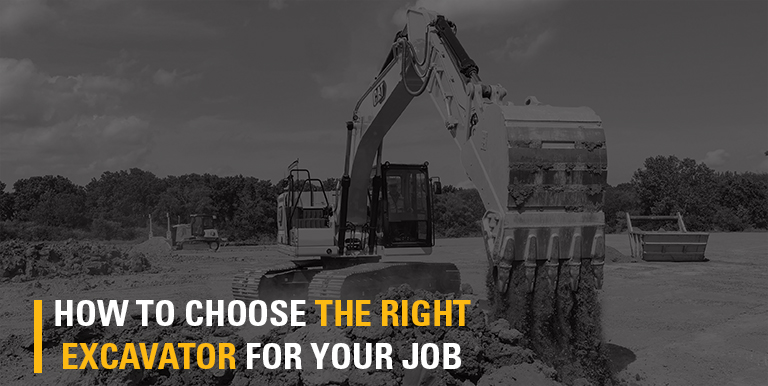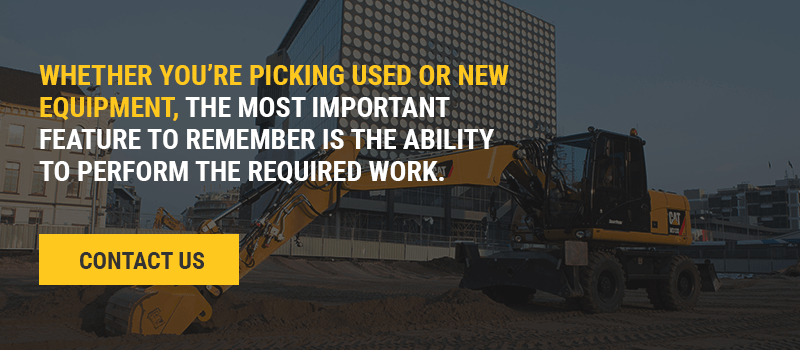After you’ve secured a new job thanks to a successful bid, it’s time to make sure you’ve got all of the right equipment. One of the most common pieces of construction equipment that companies need to complete new work is an excavator. But with all the choices available, choosing the right excavator can be a tough ordeal.
Thankfully, this guide will help you learn how to choose an excavator that meets the needs specific to your job. Match your excavator to your job requirements, the work that needs to be done and the job site itself. Be sure to get all of the feature support you may need for future jobs.
It’s best to pick a smart partner who you trust to deliver the right equipment and supply you with any parts you need for repairs and improvements down the road. Your construction supply company should meet all of the criteria below and make you feel confident about your choice.

Perform to Your Standards
Your excavator needs to get the job done, and that’s the top criteria when choosing the right excavator. To make sure you’ve got enough power for your operation, look at the hydraulic systems and testing options for your next excavator. Many will list the power of their system and note what work can be performed during a full workday thanks to that power.
More powerful hydraulic systems allow for improvements in your efficiency and productivity because you’re matching the power you need, but performance also includes the best support for your job. Consider all of the jobs your excavator will need to perform when making your choice.
Two major support options to consider are zero tail swing or zero house swing features for your excavator. These configurations allow your operator to work close to dig sites, walls and other obstacles in a safe manner.
The zero-swing for the tail allows an excavator to move nimbly and reduces the likelihood of any accidental impact with a surrounding object, building or machine. During a turn, the zero-swing for housing helps prevent your operator from hitting the front and sides of the excavator when moving.
Zero-swing options are smart if you’re working in a space with a lot of obstacles on either side. However, this configuration means a wider excavator, and that isn’t always suitable for a worksite.
Almost all excavators have an advantage over the traditional backhoe: the boom is independent. This allows your operator to manage the machine and create a stable base that needs to be moved less. You’re getting better visibility and power with smoother operations.
Match It to Your Site
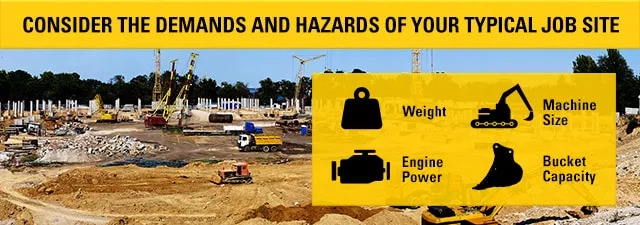
What does your job site look like? Picture it, including the hazards and your current needs, plus those you expect as your project moves through each phase. The best way to make sure you’re covered with your excavator purchase is to imagine all of your possible needs.
If you’re running a big operation or need equipment for the long haul, it’s best to judge the excavator based on your typical jobsite. Different models perform better on large, flat landscapes, compared to urban environments where there are many buildings and obstacles nearby.
After you consider your location, think about the jobs performed on your average site. The right excavator for your company must be able to perform your common reach, dig, lifting, carrying and other functions. Review past jobs and take proper measurements, such as loads or how deep your digs were.
Consider the following top specifications to match an excavator to your job:
- Engine power. You need an engine strong enough to get around your jobsite and perform tasks. When digging deep into specifications, include the bore and piston stroke so you can compare the strength of different engines.
- Weight. Focus on the maximum operating weight, which will cover the equipment, operator and load options. You don’t want an excavator that’s too heavy and will damage your site.
- Size. Make sure your excavator can fit in your site. Typically excavators are sized based on tonnage, corresponding to their operating weight. As tonnage goes up, breakout force goes up proportionally.
- Bucket capacity. Because buckets are among the most common use for excavators, check the types of buckets it supports and the maximum capacity of the bucket option.
Size Matters
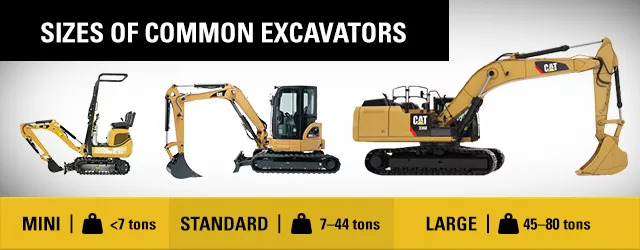
While you’re thinking about your job standards and the common jobsite you work with, start the process of narrowing your search. Begin with reviewing the size and type of excavators. Remember that categories are general and specifications may differ by manufacturer, so get your mind set on a size —such as 5 tons —instead of a “mini.” Consider the following top types of excavators:
- Mini or compact. These small excavators are typically the most mobile. They can weigh from as low as 2,100 pounds to just under 10 tons. A mini is a top choice for small jobs and those with tight space requirements, such as those that require the ability to maneuver around a building or work in areas with many lines running through the ground. These require the least amount of power, but they’ll also do the least amount of damage to the yard, road and sidewalk.
- Standard. Excavators that are larger than 10 tons and below 45 tons fall into the standard designation. These are the most versatile excavators, working well in just about any space and with most types of jobs. They come with a lot of power, so it’ll be heavy and do a little damage to the land it has to cross. You’ll need plenty of space, but they’re strong and easy to transport. They’re common in the construction space.
- Large. Excavators can reach up to 95 tons, and these behemoths fall into the large category. These machines are pure industrial workhorses. You won’t see them in urban environments or those with a lot of slopes around the work site, but they constantly provide power for major construction. These machines will require a significant investment in the equipment and trailer to move them to each job site. If you need this size and power, you’ll know it.
There are many different configurations available in each segment. Modern designs now allow standard and mini excavators to be more versatile for a variety of work situations. These include the options for the undercarriage to retract and let an excavator move through narrow areas such as fence gates, and then expand when they need a solid base to perform the work.
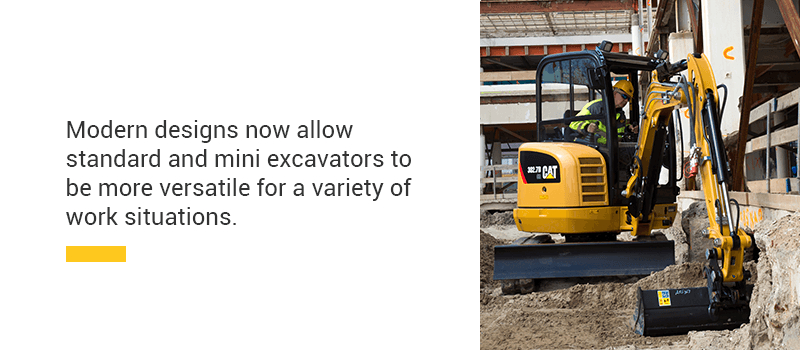
Why Use a Mini Excavator?
While some applications require the power of a standard or large excavator, power isn’t everything when it comes to certain jobs. Mini excavators offer several advantages over their larger counterparts, including:
- Less impact. Because they are smaller and lighter, mini excavators leave reduced track marks and cause less ground damage.
- Smaller footprint. Compact mini excavators are easier to work with when a work site is small or crowded, like a parking lot.
- Easy transport. Mini excavators can be loaded onto the back of a utility truck or relatively small trailer for simple transfer between job sites.
- Low transportation weight. Several Cat mini excavator models have an operating weight of less than 10,000 lbs., which means you may be able to trailer and tow a mini excavator with a standard Class C California driver’s license.
Mini excavators are ideal for jobs that take place within a tight area. Working in a backyard, for example, involves having to maneuver through gates and around a small space. A mini excavator can perform the same functions a standard excavator can, but it does so on a smaller scale. This can significantly speed up jobs where digging would otherwise have to be done manually.
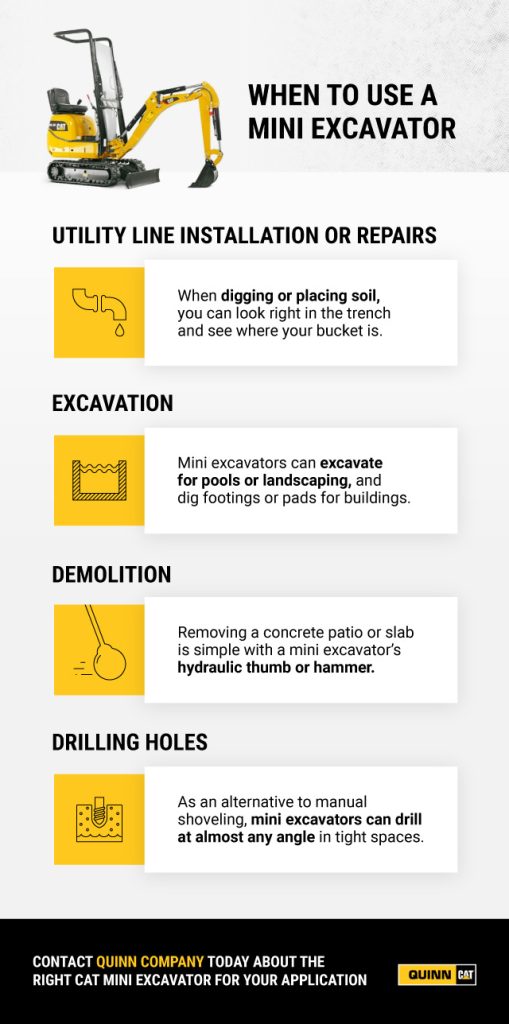
When to Use a Mini Excavator
What is a mini excavator good for? Mini excavators have a variety of possible attachments that make them highly versatile. With their light frame and compact size, there are more uses for mini excavators than you might expect. Here are four examples of jobs where this type of machine is a good option.
What is a mini excavator good for? Mini excavators have a variety of possible attachments that make them highly versatile. With their light frame and compact size, there are more uses for mini excavators than you might expect. Here are four examples of jobs where this type of machine is a good option.
1. Utility Line Install or Repair
An excavator is a great tool for digging trenches for line install or replacement. When digging with the excavator you are looking right in the trench that you are looking to dig, where digging with a trencher you are trenching behind you. Also you are able to place your spoil where you need it vs the side of the trench where you might have to use another tractor to move it.
2. Excavation
When needing to dig out an area the excavator can be the perfect tool. With the excavator you can swing the machine 360 degrees so you can dump the material where you want it. Pool Excavation, landscaping & building pad excavation is almost completely performed by excavators. Another advantage with excavators is when you need to over-excavate a pad for compaction you can easily meter in the material to the desired thickness for proper compaction. Also another great application for the excavator is digging footings for retaining walls or buildings.
3. Demolition
If you are removing a concrete patio or a structure a mini excavator can be very handy. You can have the machine equipped with a hydraulic thumb to hold the debris while tearing them out & loading the truck or trailer to take them away. You can also add a hydraulic hammer or breaker to bust up concrete slabs or rocks.
4. Drilling Holes
The mini excavator’s ability to maneuver in tight spaces makes it an essential tool on job sites where you need to drill holes in multiple awkward areas. Using a mini excavator means workers don’t have to resort to manual shoveling or using other hand tools to drill the holes. Also with the mini excavator you can reach over obstacles & drill at almost any angle. Since the auger is hydraulic driven where ever the end of the excavator stick is you can drill a hole.
Operator Comfort Is Important
Selecting the right excavator involves matching the excavator to your needs. This should also include pairing the right excavator with your operators.
Many models are focused on the comfort of the operator through the use of ergonomic chairs and controls. Look for a cab that has plenty of room and allows for easy access to all of the controls and features of the excavator. Adjustable seats with lateral movements allow your operator to work comfortably, providing enough flexibility to quickly accommodate different operators.
Part of the comfort equation for how to choose an excavator should also include a heating and air conditioning system. These need to be powerful enough to maintain comfort in your region. Many new cabs offer controls similar to those in cars and trucks. Take a peek at these and make sure the controls are easy to understand. Look for two vents: one in front of and one behind the operator’s seat.
The longer your operators will need to use the excavator in a single sitting, the more comfort should play a role in your selection. When wondering how to buy an excavator, choose one that will help maintain performance instead of work against it.
The Right Tools for the Job
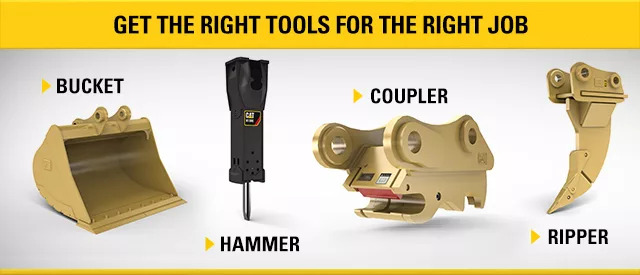
Choosing an excavator changes when you’re looking to work beyond digging. If you need a versatile machine, it’s time to consider the attachments that it supports. Excavators can be expanded with a wide range of support equipment for different jobs, and some of the most common are as follows:
- Buckets – Buckets are the most versatile extension of your excavator, with a variety of different styles for digging, grading, ditch cleaning and more, with options to match to the severity of your workload.
- Couplers – These attachments allow your excavator to quickly switch tools without needing a crew. This means your machine can move between multiple tasks as you move about the job site.
- Compaction – Both compaction wheels and vibratory plates and useful for pipeline contractors and site preparation.
- Rippers – Break up hard soil or even ice on the ground with a ripper. These are common for trenching and pipeline support, with options to support couplers and a variety of different depths.
- Hammers – Excavators are commonly used in demolition, taking down buildings and pavement. Hammers make quicker work of this effort, particularly being able to swap between the tool and a bucket with the use of a coupler.
You’ll typically match your excavator with attachments from the same manufacturer. This is a good idea because it’ll help with warranties. It also ensures that your attachment functions properly with the unique mounting system of your excavator. It’s especially important to match equipment and your excavator when you use a hydraulic actuated system because it manages your attachment changes with the simple push of a cab button.

Additional Features for Selecting the Right Excavator
There are some secondary features you should also consider when you’re finalizing your excavator purchase. These can help you choose the right excavator by providing you with a checklist to compare your top options.
Some of the more important secondary features include the following:
- Anti-vandalism features. These options include the ability to lock different parts and locations on the machine so it cannot be used and nothing can be removed. These are useful if you need to leave your excavator on-site. This allows you to protect your equipment and jobsite, while giving you a shield against liability for anyone injured after sneaking onto your site.
- Power modes. Different power distribution modes include power options for your attachments and boom. Some will also include a way to provide extra power to your tracks. These systems allow you to increase performance in common situations that your equipment will face.
- Hydraulic controls. Newer excavators have introduced top-of-the-line hydraulics into the cab to help improve control. It allows your operator to be precise with movements and makes overall operation easier. Ergonomic setups will also make the performance more comfortable for your operator.
These considerations are very important when you’re focusing on how to buy an excavator.
Before Choosing an Excavator
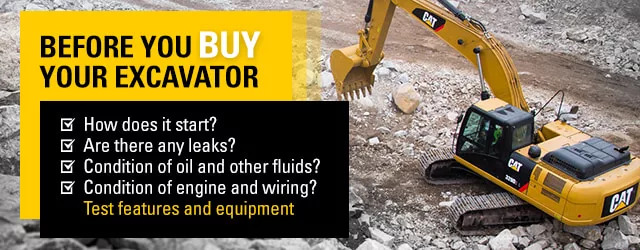
Get your hands on the excavator itself and take it for a spin before making any purchase. You need a good, hands-on experience with any machine before you provide funding. This part of the process is just as important as settling on the model that you want to use because every excavator is unique.
When reviewing your potential excavator, be sure to check the following:
- Observe how it starts up. It’s better for the engine to start right away and not need time to pull from the battery.
- Check for any leaks or smoke. While some water may leak from an AC system and engines can produce a small amount of smoke, always check to see if these are within the norm for the machine. Check any fluid leak and make sure it’s not a vital system.
- Review the condition of the oil and other fluids of the machine. These should be fresh, but it may be a warning sign if someone is trying to sell you a machine with old hydraulic or other oils.
- Open it up and quickly look at the engine and wiring. You want everything to look like it’s in good shape and you want the wiring to look professional. Electrical tape throughout can be a warning sign.
- Test the features and equipment. For example, you can review slew ring wear by lifting the boom and moving the body by hand. A little play in the swivel mechanism is okay for swivel booms, so you’re looking for excessive movement or apparent wear when you do move it.
A thorough check can save you a lot of headaches, repairs and money. Plus, it helps you keep your workers safe, and that’s the biggest benefit of all.
Choosing the Right Excavator
Learning how to buy an excavator is an exercise in time, as you make sure to meet your company’s every need.
An excavator can make a top addition to your equipment because of its versatility and usefulness throughout the entire construction cycle. From grading for your foundation and lifting materials to your workers to providing the power for your demolition, excavators are always present in the construction yard.
Quinn Company, your trusted source since 1919, can help you finalize your selection and define your work requirements. Whether you’re picking used or new equipment, the most important feature to remember is the ability to perform the required work. Narrow your choice by considering space limitations, optional features, attachment support and more.
And after that final check, you can be sure that you know how to choose an excavator that’s right for your needs. The right partner can make the choice even easier. Contact Quinn Company today.


